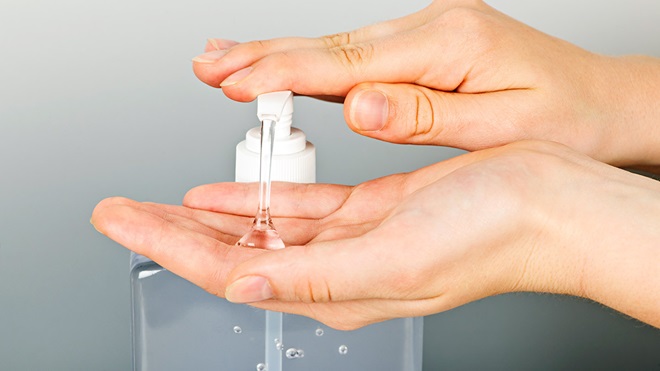As the COVID-19 coronavirus crisis continues, many supermarkets and pharmacies are either limiting the sales of hand sanitiser or have simply run out altogether.
Some online sellers are taking advantage of the shortage by offering hand sanitiser at a huge markup, attracting accusations of price gouging.
So should we be making our own hand sanitiser? A quick search online results in a multitude of homemade recipes with claims they're similarly effective as commercial products.
But do they really work? We look at what you need to know before making your own hand sanitiser.
Note: As a result of the high demand for hand sanitisers, Australia's Therapeutic Goods Administration (TGA) announced there are now three classes of hand sanitiser: general consumer products ('cosmetics'), therapeutic goods, and products with one of two specific formulations (excluded from TGA regulation for the duration of the COVID-19 pandemic).

Washing your hands with soap and running water for at least 20 seconds is still the most effective way to eradicate germs.
Handwashing is still best
Proper hand hygiene is vital for limiting the spread of coronavirus as well as colds and flu.
Despite the soaring popularity of hand sanitiser in recent weeks, studies and experts agree that regularly washing your hands with soap and running water for at least 20 seconds is still the most effective way to eradicate germs.
"Handwashing with soap and water is the best thing to use to kill this virus," physician Dr Norman Swan tells CHOICE.
It's only when you don't have access to soap and water that you should use a hand sanitiser.
Not all recipes are reliable
To be effective at killing germs, hand sanitisers must contain an alcohol concentration of 70–95%.
Many of the online recipes we've seen do include this as the main ingredient, while others suggest using essential oils instead of alcohol as the main ingredient – rendering it ineffective in the fight against coronavirus, let alone any other virus.
Commercial hand sanitisers also contain emollients to keep your skin soft and reduce any damage. Important, because dry and damaged skin can increase the risk of viruses entering through cuts in the skin
Other articles or blog posts reference the guidelines released by the World Health Organization. Only problem? Those guidelines aren't aimed at the average DIY enthusiast and require a number of materials you're unlikely to have lying around, such as an alcoholometer and large quantities of highly flammable ingredients.
Commercial hand sanitisers also contain emollients to keep your skin soft and reduce any damage. Important, because dry and damaged skin can increase the risk of viruses entering through cuts in the skin. While many DIY recipes suggest adding aloe vera for its moisturising properties, if you don't get the ratio right you run the risk of diluting the alcohol concentration, rendering it ineffective.
WHO's guidelines aren't aimed at the average DIY enthusiast and require a number of materials you're unlikely to have lying around
But even if you do find a recipe that includes the correct concentration of alcohol and an emollient, many experts still don't recommend making hand sanitiser yourself.
As Richard Sachleben, an organic chemist and member of the American Chemical Society, tells our sister organisation Consumer Reports: "Companies spend a bunch of time and money to pay chemists specifically to formulate hand sanitisers that work and that are safe. If you make it yourself, how can you know if it's stable or if it works?"
Lack of available ingredients
If you've been thinking about making your own hand sanitiser, it seems you're not the only one. As hand sanitiser (and most other basic household essentials) has been disappearing from shelves, we've heard reports that common ingredients for DIY hand sanitiser are also becoming harder to find.

Don't waste perfectly good vodka by using it as a hand sanitiser.
Can I use vodka to make hand sanitiser?
In lieu of alcohol-grade ingredients such as ethanol or isopropyl alcohol, some online recipes suggest using vodka.
Ironically, while Absolut Vodka has pledged to distribute high-alcohol neutral spirit in Sweden for use in hand sanitisers, using store-bought vodka to make a DIY version isn't recommended as most products don't contain a high enough percentage of alcohol to kill the coronavirus on its own, let alone when it's diluted with additional ingredients such as aloe vera and essential oils.
How to use hand sanitiser
Whether it's a commercial product or homemade, hand sanitiser is only effective if you use it properly.
Luckily, it's usually as simple as applying hand sanitiser to the palm of one hand (read the label for the correct amount) then briskly rubbing it all over the surfaces of your hands until dry.
The NSW Department of Health has also created a handy visual reminder to encourage hand hygiene.

Credit: NSW Department of Health
We're on your side
For more than 60 years, we've been making a difference for Australian consumers. In that time, we've never taken ads or sponsorship.
Instead we're funded by members who value expert reviews and independent product testing.
With no self-interest behind our advice, you don't just buy smarter, you get the answers that you need.
You know without hesitation what's safe for you and your family. And our recent sunscreens test showed just how important it is to keep business claims in check.
So you'll never be alone when something goes wrong or a business treats you unfairly.
Learn more about CHOICE membership today
Stock images: Getty, unless otherwise stated.



